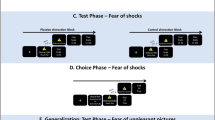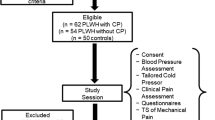Abstract
Women tend to report greater acute and chronic pain intensity than men, and various mechanisms have been proposed to account for these sex differences. Suppression has been related to amplified pain intensity, and thus we examined whether sex differences in the use of suppression partly explained the discrepancy between men and women on pain report. Participants (N = 222; women: 55%) underwent a cold pressor, during which half the sample was randomly assigned to suppress pain-related thoughts and feelings and the other half was not. A 2-min recovery period followed the cold pressor. Ten min later, all participants were exposed to another physical stimulus (a massage device). Significant condition × Sex interactions were found for pain intensity, sensory ratings from the McGill Pain Questionnaire and unpleasantness ratings for the massage device, such that: (a) men in the No Suppression condition reported lower pain and unpleasantness than women in the same condition; (b) men in Suppression condition reported greater pain and unpleasantness then men in No Suppression condition, but equivalent pain and unpleasantness to women in No Suppression condition; (c) differences between men and women on pain in No Suppression condition were partly mediated by women’s report of greater spontaneous use of avoidance/suppression during the cold pressor. Results using an “addition” paradigm (i.e., manipulating use of suppression) and a “take away” (i.e., mediation) paradigm converge to suggest that women spontaneously use suppression to regulate pain more than men, and that the differential use of suppression partly explains the tendency for women to report greater pain intensity than men.



Similar content being viewed by others
References
Blumberg, S. J. (2000). The white bear suppression inventory: Revisiting its factor structure. Personality and Individual Differences, 29, 943–950.
Burns, J. W. (2006). The role of attentional strategies in moderating links between acute pain induction and subsequent emotional stress: Evidence for symptom specific reactivity among chronic pain patients versus healthy nonpatients. Emotion, 6, 180–192.
Burns, J. W., Quartana, P. J., & Bruehl, S. (2008). Anger inhibition and pain: Conceptualizations, evidence and new directions (invited). Journal of Behavioral Medicine, 31, 259–279.
Cioffi, D., & Holloway, J. (1993). Delayed costs of suppressed pain. Journal of Personality and Social Psychology, 64, 274–282.
Edwards, R. R., Fillingim, R. B., Maixner, W., Sigurdsson, A., & Haythornthwaite, J. (2004). Catastrophizing predicts changes in thermal pain responses after resolution of acute dental pain. The Journal of Pain, 5, 164–170.
Elfant, E., Burns, J. W., & Zeichner, A. (2008). Repressive coping style and suppression of pain-related thoughts: Effects on responses to acute pain induction. Cognition & Emotion, 22, 671–696.
Fillingim, R. B., King, C. D., Ribeiro-Dasilva, M. C., Rahim-Williams, B., & Riley, J. L. (2009). Sex, gender, and pain: A review of recent clinical and experimental findings. Journal of Pain, 10, 447–485.
Goodin, B. R., McGuire, L., Allshouse, M., Stapleton, L., Haythornthwaite, J. A., Burns, N., et al. (2009). Associations between catastrophizing and endogenous pain-inhibitory processes: Sex differences. Journal of Pain, 10, 180–190.
Keefe, F. J., Lefebvre, J. C., Egert, J. R., Affleck, G., Sullivan, M. J., & Caldwell, D. S. (2000). The relationship of gender to pain, pain behavior and disability in osteoarthritis patients: The role of catastrophizing. Pain, 87, 325–334.
Keogh, E., & Denford, S. (2009). Sex differences in perceptions of pain coping strategy usage. European Journal of Pain, 13, 629–634.
Keogh, E., Hatton, K., & Ellery, D. (2000). Avoidance versus focused attention and the perception of pain: Differential effects for men and women. Pain, 85, 225–230.
Masedo, A. I., & Esteve, M. R. (2007). Effects of suppression, acceptance, and spontaneous coping on pain tolerance, pain intensity and distress. Behaviour Research and Therapy, 45, 199–209.
Melzack, R. (1987). The short-form of the McGill Pain Questionnaire. Pain, 30, 191–197.
Ninot, G., Fortes, M., Poulain, M., Brun, A., Desplan, J., Prefaut, C., et al. (2006). Gender differences in coping strategies among patients enrolled in an inpatient rehabilitation program. Heart and Lung, 35, 130–136.
Nolen-Hoeksema, S., Larson, J., & Grayson, C. (1999). Explaining the gender difference in depressive symptoms. Journal of Personality and Social Psychology, 77, 1061–1072.
Peterson, B. D., Newton, C. R., Rosen, K. H., & Skaggs, G. E. (2006). Gender differences in how men and women who are referred for IVF cope with infertility stress. Human Reproduction, 21, 2443–2449.
Robichaud, M., Dugas, M. J., & Conway, M. (2003). Gender differences in worry and associated cognitive-behavioral variables. Journal of Anxiety Disorders, 17, 501–516.
Robinson, M. E., Riley, J. L., Myers, C. D., Papas, R. K., Wise, E. A., Waxenberg, L. B., et al. (2001). Gender role expectations of pain: Relationship to sex differences in pain. Journal of Pain, 2, 251–257.
Sullivan, M. J. L., Rouse, D., Bishop, S., & Johnston, S. (1997). Thought suppression, atastrophization, and pain. Cognitive Therapy and Research, 21, 555–568.
Thorn, B. E., Clements, K. L., Ward, L. C., Dixon, K. E., Kersh, B. C., Boothby, J. L., et al. (2004). Personality factors in the explanation of sex differences in pain catastrophizing and response to experimental pain. Clinical Journal of Pain, 20, 275–282.
Wang, C., Cheng, Y., Liu, T., Li, Q., Fillingim, R. B., Wallace, M. R., et al. (2008). A computational model for sex-specific genetic architecture of complex traits in humans: Implications for mapping pain sensitivity. Molecular Pain, 16, 13–23.
Wegner, D. M. (1994). Ironic processes of mental control. Psychological Review, 101, 34–52.
Wenzlaff, R. M., & Wegner, D. M. (2000). Thought suppression. Annual Review of Psychology, 51, 59–91.
Wiesenfeld-Hallin, Z. (2005). Sex differences in pain perception. Gender Medicine, 2, 137–145.
Acknowledgments
This work was partly supported by grant R01-MH071260 from the National Institutes of Health.
Author information
Authors and Affiliations
Corresponding author
Rights and permissions
About this article
Cite this article
Burns, J.W., Elfant, E. & Quartana, P.J. Suppression of pain-related thoughts and feelings during pain-induction: sex differences in delayed pain responses. J Behav Med 33, 200–208 (2010). https://doi.org/10.1007/s10865-010-9248-x
Received:
Accepted:
Published:
Issue Date:
DOI: https://doi.org/10.1007/s10865-010-9248-x




